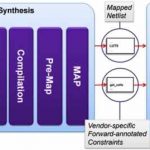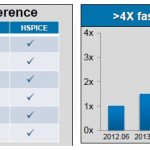You are currently viewing SemiWiki as a guest which gives you limited access to the site. To view blog comments and experience other SemiWiki features you must be a registered member. Registration is fast, simple, and absolutely free so please,
join our community today!
Both Altera and Xilinx are innovative companies with robust ecosystems, right? It would be a terrible shame if you located the perfect FPGA IP block for a design, but couldn’t use it because it was in the “wrong” format for your preferred FPGA. What if there were a way around that?
There is a compelling argument to use each FPGA vendor’s… Read More
HSPICE – 35 and looking good!by Tom Dillinger on 02-01-2016 at 12:00 pmCategories: EDA, Synopsys
A maturetool. A legacytool. A tool that’s a little long in the tooth. We have all used these terms to refer to an EDA product that has not been able to keep up with technical challenges of model complexity, performance, or new features required by current SoC and system design requirements.… Read More
A unique phenomenon has started manifesting itself under the slew of mergers and acquisitions this year in the semiconductor landscape. This phenomenon is bound to intensify in the near future and would positions itself as a key factor for the future of the semiconductor industry. The winners and losers in the game would be determined… Read More
The battle between Xilinx and Altera continues to be one of the more interesting stories to cover. It really is the semiconductor version of a reality TV show. In the beginning it was two fabless companies partnered with rival foundries going head-to-head controlling a single market that touches a variety of industries.
Then things… Read More
Why do I stalk the FPGA industry? Well, FPGAs are an important part of the fabless semiconductor ecosystem for two reasons: 1.) They enable very cost effective design starts which are the life’s blood of the semiconductor industry and 2.) FPGA prototyping allows designers to verify their designs before committing to silicon and… Read More
At TSMC’s OIP Symposium recently, Xilinx announced that they would not be building products at the 10nm node. I say “announced” since I was hearing it for the first time, but maybe I just missed it before. Xilinx would go straight from the 16FF+ arrays that they have announced but not started shipping, and to the… Read More
While I was at the imec Technology Forum someone asked me “Why did Intel pay $15B for Altera?” (the actual reported number is $16.7B).
The received wisdom is that Intel decided that it needs FPGA technology to remain competitive in the datacenter. There is a belief among some people that without FPGA acceleration available for vision… Read More
When the news broke about the on, off, and on-again Intel-Altera merger a few weeks ago, I checked off another box on my Six Degrees of Kevin Bacon scorecard. That plus a $5 bill gets me a Happy Meal at McDonalds, but in a post-Altera world, it might be worth more.
On January 16, 2008, I’m sitting in a meeting with some Intel strategic marketing… Read More
Intel’s 10nm may be reliving the 14nm elongated delay issue-
Schedules & tool delivery may be pushed even deeper into 2016-
Meanwhile Samsung & TSMC press on-
Could Intel be embarrassed?
… Read More
You should be happy to listen that Intel will buy Altera FPGA challenger, if you expect always more power to be consumed in datacenter! In 2013 the power consumption linked with the Servers and Storage IC activity, plus the electricity consumed in the systems cooling these high performance chips has reached 91 BILLION KWh (or the… Read More



